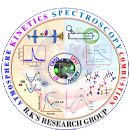The kinetics and thermochemistry for the fundamental reactions involved in low temperature autoignition of 2-pentanone were investigated by computational methods. CBS-QB3, a complete basis set method, was employed to calculate the thermodynamic parameters for the various species involved. The present study involves the decomposition pathways of alkylperoxy (ROO•), hydroperoxyalkyl (•QOOH) and hydroperoxyalkylperoxy (•OOQOOH) radicals formed in 2-pentanone, as these radical intermediates are important for chain branching at low temperature combustion which can be useful in modeling the autoignition. 1,6 and 1,5 H-migration reactions are the most favorable channels for the decomposition of ROO• radicals to form their respective •QOOH radicals. 1,6 H-migration occurring in R1OO• and R3OO• radicals have 16.1 and 22.0 kcal mol−1 as their energy barriers which are lowest when compared to the energy barriers for all the other reactions involved in the decomposition of these radicals. Similarly, in case of R2OO• and R4OO• radicals, the 1,5 H-migration reactions have very low barriers (20.7 and 18.8 kcal mol−1) respectively. For •OOQOOH radicals, the peroxy radical interconversion (•OOQOOH to HOOQOO•) has lower energy barriers (10.4 to 14 kcal mol−1), but the decomposition proceeds with either HO•2-elimination or other H-migration reactions. Rice-Ramsperger-Kassel-Marcus (RRKM) calculations were performed to study both the temperature and pressure-dependent rate coefficients in the temperature range of 400 – 1500 K and the bath gas pressures of 0.01 atm to 100 atm.
-
Call
-
E-mail
Journal Details
1. Computational investigations on the thermochemistry and kinetics for the autoignition of 2-pentanone.
S. Kuzhanthaivelan & B. Rajakumar. Combustion and Flame, , 147-160., 219
